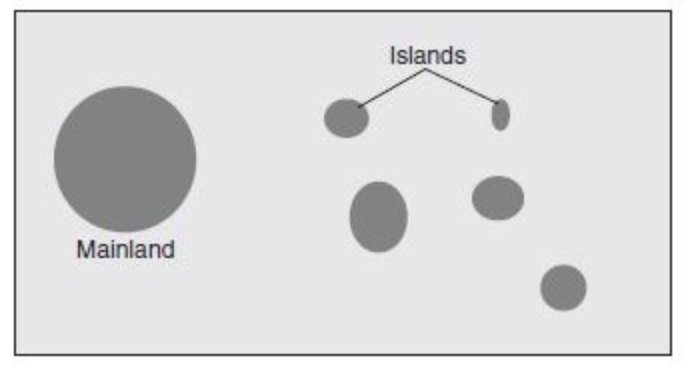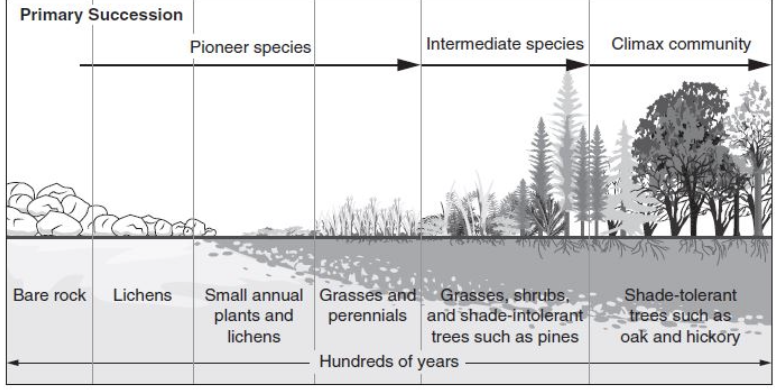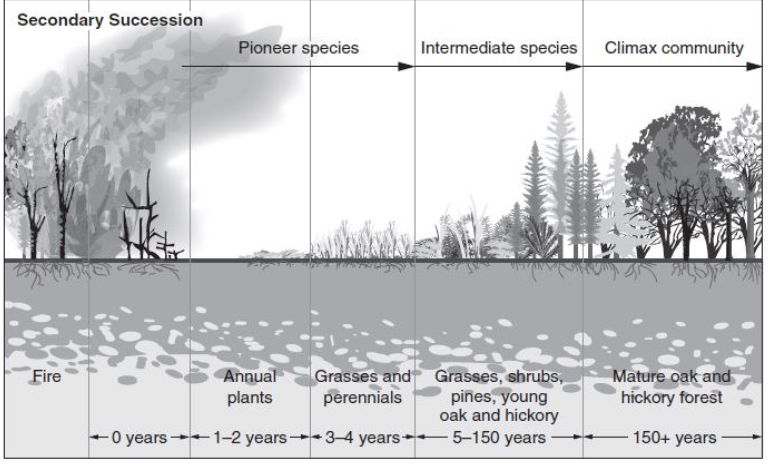Chapter 6: The Living World: Biodiversity
- Biodiversity is all the variety of life on Earth. If we lose one part of the biodiversity on our planet, other species, and entire ecosystems can be affected.
- There are both natural and human causes that can impact ecosystems and organisms must adapt to these causes.
- Ecosystems have structure and diversity that change over time
Key Terms
- Genetic diversity: Diversity within a species. Example: unless you are a twin you look different than all other humans on the planet.
- Species diversity: Number of species and abundance in a community. Example: the bears, rabbits, toads, ferns, and oak trees in an area.
- Habitat diversity: How many different habitats are in a region. Example: tropical rain forest, tropical dry forest, grasslands.
- Population bottleneck: A population that has been reduced because of an environmental event. Ecosystems with many different species are more likely to recover from an environmental event than ecosystems with fewer species.
- Species richness: The number of species per sample. The more species present in a sample, the “richer” the sample.
- Provisioning service: Ecosystem services that give humans what they need to survive, like food and clean water.
- Regulating service: Ecosystem services that indirectly benefit humans, such as plants cleaning the air and bees pollinating plants.
- Cultural service: Ecosystem services that provide humans beauty, art, and enjoyment.
- Supporting service: Ecosystem services such as producing oxygen, water cycling, and other services that support human life.
- Island biogeography: Study of the species and distribution that would occur on islands. There are usually more species on islands closer to the mainland (more migration from the mainland) and larger islands that can hold more species.
- Specialists: Organisms that require specific habitats, food, etc., like a koala.
- Generalists: Organisms that can live in many places and eat many things, like a cockroach.
- Ecological tolerance: The total range of conditions organisms can live in. Each species has its own ecological tolerance before it dies.
- Adaptations: Biological and behavioral ways organisms adapt over time to survive.
- Primary succession: Bare rock, such as after a volcanic eruption, over time becomes a climax community. Moss or lichen usually inhabit first, break down rock to make soil, and afterward larger and larger plants move in. This is a slow process.
- Secondary succession: After a fire or flood destroys the habitat, but the soil remains. Over time it becomes a climax community as new plants begin move in. This is faster than primary succession.
- Keystone species: Species that many other species depend on.
- Indicator species: Species that indicate an environmental problem.
- Pioneer members: First members into an area after a fire, etc.
- Climax community: The stable stage of the environment after a disruption.
Introduction to Biodiversity
- There are three types of biodiversity: genetic, species, and habitat:
- Genetic diversity refers to the diversity within a species.
- Unless you are an identical twin, you are different from every other person on the planet. Each person has unique features such as eye color, skin color, hair color, height, and so on.
- These genetic differences also contribute to different environmental pressures, which affect organisms in different ways.
- Some organisms can withstand a particular environmental pressure while others will die.
- Genetic diversity is important because it helps maintain the health of a population.
- Species diversity is the number of species and abundance of each species that live in a particular community.
- Species diversity helps to contribute to the health of an ecosystem because each species has an important role in this heath.
- Habitat diversity is the different habitats found in a certain region.
- Since a habitat is a home to plants and animals, how diverse a habitat is can tell us about the health of the area.
- Genetic diversity is a way for populations to adapt to changing environments and allows for the population to better respond to environmental stress.
- With more variation, it is more likely that some individuals in a population will possess variations of alleles that are suited for the environment and it is more likely that these individuals will survive and reproduce.
- A population that has been reduced for a generation or more, usually due to an environmental event like a drought or flood, is a population bottleneck.
- This reduces genetic variation and can lead to a loss of biodiversity.
- Ecosystems with many different species are more likely to recover from an environmental event than ecosystems with fewer species.
- Specialists are organisms that require particular habitats, food, and so on.
- An example of a specialist species would be a koala, who can only eat eucalyptus.
- If the habitat where koalas live is damaged and their specific food source is gone, this could be particularly devastating to the population of koalas.
- Generalists are the opposite. They can live in many different places and eat many different things.
- Generalists are less likely to be impacted by an environmental event.
- For example: a cockroach, who can live almost anywhere and eat almost anything.
- Species richness is the number of species per sample. The more species present in a sample, the “richer” the sample.
- It is a count of the species, not the abundance or number of individuals of each species present. It gives as much weight to those species that have very few individuals as to those that have many individuals.
- Thus, one cactus has as much influence on the richness of an area as 1,000 dandelions.
Ecosystem Services
- You as a human benefit from healthy ecosystems.
- These are tangible items like food, money, medicine, and more.
- Human activities can damage these services both economically and ecologically.
- Scientists break these services into four categories:
- Provisioning: Services like food and clean water.
- Regulating: Services like plants cleaning the air, bees pollinating flowers, plants holding soil in place to prevent erosion, or the regulation of climate by natural processes.
- Cultural: Services that are not tangible things that benefit us but rather interactions with nature, such as taking a walk and enjoying what you see or art that comes from looking at nature, and so on.
- Supporting: These are harder to understand but are the ecosystem services that support all other others, such as producing oxygen, water cycling, and so on.
Island Biogeography
Figure 6.1 is an example of a mainland with several small islands located different distances away from the mainland.
You can see that each island is a different size.
Island biogeography is the study of the species and distribution that would occur on each of these islands.
- The theory states that islands closer to the mainland (where the animals/plants have moved from) and/or larger islands will have more species than islands farther away or smaller.
- The size of the island in theory matters because larger islands can support more and different species while smaller ones would be more limited.
- A real-life example would BE: New Guinea is 50 times the size of Bali therefore there are more birds on the island of New Guinea than the island of Bali.

Because an island is a special kind of environment, isolated and where species can’t move easily, species on islands react to environmental pressures differently than species on continents.
- Islands have limited resources like food and habitats.
- Islands also often have specialists living on them.
- These species have adapted to become a specialist because of the unique characteristics on islands such as limited food or habitat resources.
- Because specialists are more likely to be impacted by human and/or natural events, such as the introduction of a nonnative (invasive) species, they could become threatened.
Ecological Tolerance
- All organisms have a range of conditions that they can survive in.
- Consider a goldfish in a bowl. If you put that bowl out in the sun in Texas in the middle of the summer, it will result in a dead goldfish.
- This is because a goldfish has an ecological tolerance for temperature and the water temperature in the bowl has gone above that.
- Other ecological tolerances in addition to temperature are salinity, sunlight, flow rate, and availability of water. These tolerances can apply to species or to individuals.
Natural Disruptions to Ecosystems
- Ecosystems can be impacted by natural factors such as fire, climate change, sea level rising, and more.
- These disruptions may be short/fast as in a fire, or slow/long over thousands or millions of years such as natural impacts of climate change.
- For example, a fire might have a large impact immediately, but the area will recover in a few years and after a few decades you might not even know a fire had even occurred.
- An example of a slow/long change is climate. It has changed many times over millions of years, which has resulted in sea levels rising and falling over this time span.
- Sea levels respond to changes in ice on our planet and as land ice melts sea levels rise. All of these changes, both fast and slow can impact habitats and impact wildlife.
- Periodic: This is a change that occurs at regular intervals, for example, the tides that comes in every day at a predictable time.
- Episodic: This means it happens in irregular intervals. It repeats but irregularly, for example, El Niño and La Niña.
- Random: This is something that is totally random and can’t be guaranteed to repeat. It might happen once or multiple times, for example, a meteor striking the Earth.
Adaptations
- We have discussed both short- and long-term changes as well as both natural and human-caused changes.
- In order for organisms to survive these changes they have to be able to adapt. This is done by incremental changes at the population level.
- The different ways organisms can adapt are biological (structural) adaptation and behavioral adaptation.
- Keep in mind these genetic adaptations do not happen over a lifetime or even over a few generations but rather take thousands of years and multiple generations before they are found in a species.
- Organisms that can’t adapt to both short- and long-term environmental changes may not survive.
Ecological Succession
There are two ways that habitats or communities change over time. One is primary succession and the other is secondary succession.
Primary succession occurs when an area has barren rock with no soil; for example, a new volcanic island (Figure 6.2).
- First, lichens will come in and begin to break down the rock.
- After small amounts of soil are formed, small annual plants followed by grasses and perennial plants will arrive.
- More soil will now form because these “pioneer” plants break down the rock and form soil.
- Larger plants, grasses, and fast-growing trees like conifers will then grow.
- Finally, after hundreds of years hardwood trees will be established in the area.
Secondary succession is a much faster process and occurs after a disturbance of some kind (Figure 6.3).
- This could be a fire, flood, or human activity like farming.
- Because soil is already well established, plants can return faster than without soil.

